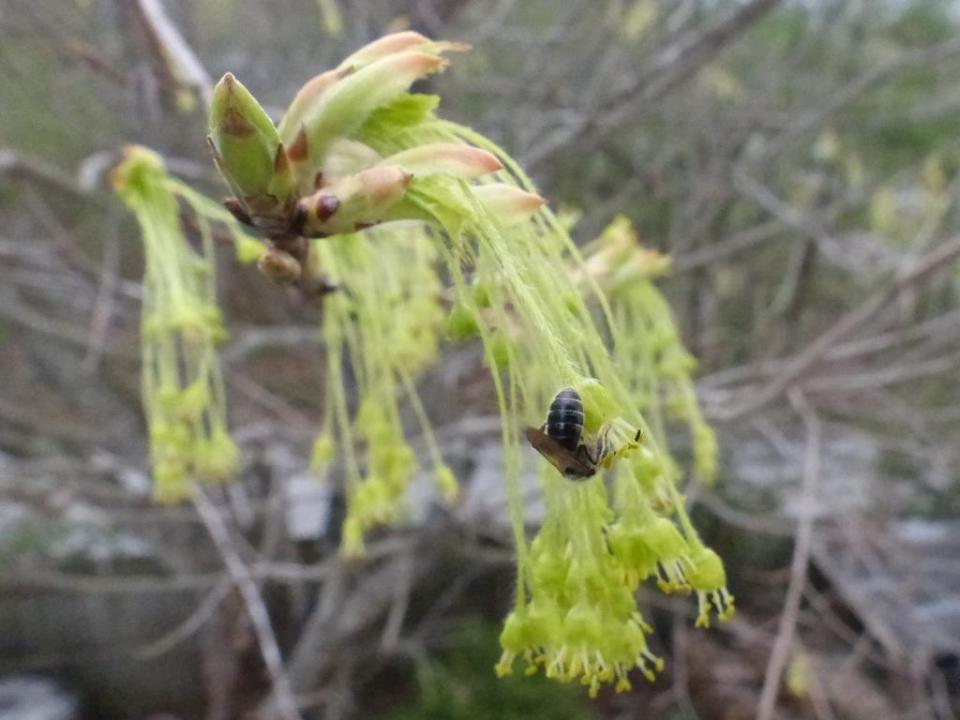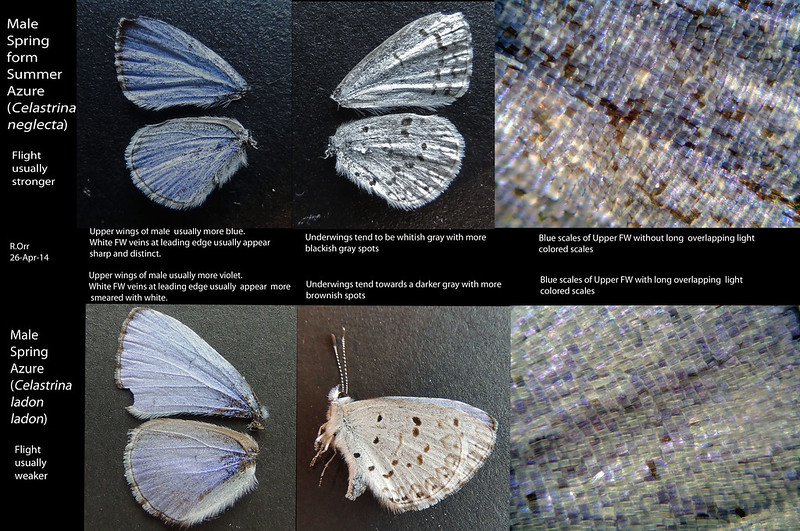Sugar maple is in bloom, shaking its anthers in the breeze. This species is supposedly wind-pollinated, but looking closely at the male flowers I saw thousands of bees, wasps, beetles, and even a butterfly working at the blooms. I estimated about thirty thousand insects on the tree’s flowers at any one time. Some were gathering pollen, but many had their heads buried in the bells from which the filaments and anthers hung. Could there be nectar or sugary exudate up there? Why else would a spring azure butterfly systematically work its way across the tree’s flowers? I can find no reference to sugary lures in any of the sources that I’ve read. I’d welcome other observations or insights…
- Comment
- Reblog
-
Subscribe
Subscribed
Already have a WordPress.com account? Log in now.


Time to bag some flowers and look at seed set!
Yes! Spoken like a true biologist, Peter. I need bags that don’t block wind, though. I’ve also thought of some ‘scope work looking for nectaries…
I observed something similar two weeks ago here in Birmingham, AL. About 15 years ago we transplanted a 5-year-old sapling of southern sugar maple (Acer barbatum) to our front lawn. Two weeks ago it surprised us with its beautiful drapery of yellow-green flowers, the first year it has flowered at age 20. Standing under its low limbs, I bent one down close, and the flowers have a very sweet smell. I was careful as I moved the limb, because the flowers were covered with bumblebees. I thought, “This tree not only has sugary sap, but also sweet flowers.” Larry Brasher
Thank you, Larry, for this observation. Fascinating. I wonder if the flowers have a North-South gradient in pollination strategies?
After the power company contractor trimmed my maples I enjoyed nectaring cedar waxwings, and that was the start of me noticing more of nature enjoying these trees. The honey bee colony living in the abandoned house next door seems to exploit the blooms and any oozy spots on the trees and the tanagers enjoy the bees. There seems to be an endless variety of bees or bee like insects on all the blooms around the lake house , but maybe a few less since the adjoining pasture has been converted to soybean monoculture.
Wow. Are these sugar or red maples? Interestingly, I saw no honey bees, even though two hives sit very close by. I will keep my eyes peeled for the tanagers.
My guess is not sugar but we didn’t plant them – they were there went we bought the house in 1987. We saw 1 male of each expected tanager last weekend so I’m sure you will be seeing and hearing them very soon. I guess I’ve only noticed summer tanagers on the bees and wasps and I am much more reluctant now to dispose of them out of deference to my beautiful summer neighbors dietary preferences.
Just summer tanagers here so far, but I have not been out in the woods enough!
Did you taste one?
Good question: just grassy flavor. I lack the exquisite sensory discernment of a bee.
You get the best comments of any blog.
I learn a great deal from readers who are generous with their insights. Thanks to people like you, Jim. :)
Here in the Pacific Northwest, big leaf maples flower in abundance and honeybees gather so much nectar from them that beekeepers sometimes get a frame or two of maple honey in the spring. It would be no surprise if sugar maples also provided nectar.
This is fascinating to know. I need to dig deeper into the botanical literature on this. Someone must have figured out where and how the nectar is produced.
It is certainly true that many insects visit sugar maple flowers. However, sugar maple has almost none of the indicators of entomophily (Faegri & van der Pijl 2013). Red maple, on the other hand, has abundant nectar, exposed nectaries, sweet fragrance, red color and strong UV absorption (Batra 1985). As Zandt observes (above), bigleaf maple is definitely entomophilous. It’s an open question whether visits to sugar maple by insects are for casual pollen harvest or whether sugar maple is actively soliciting pollination. I suspect that sugar maple lies right on the margin of pure anemophily and some entomophily, and perhaps some populations of sugar maple are better at attracting insects than others. I plan to keep looking.
Here are some of my recent observations on sex in trees: http://www.venerabletrees.org/tag/tree-sex/
Thank you, Tom! I will look more closely into this question for sugar maple. The swarms of insects seemed puzzling, given all its other flower characteristics.
WOW! What a stunning flower. As a desert dweller my only experience with sugar maple is from a bottle and on my oatmeal. Thanks for a lovely breakfast addition today.
Thank you. The bottled variety is pure forest sunshine.
Here in the mid-Atlantic, several serious butterfliers in the VA-MD-DE Bugs listserv have been discussing the difficulties of knowing what species of azure is appearing here this time of year. Perhaps this is not relevant to you in Tennessee but, if so, here’s the link to Richard Orr’s cheat-sheet for ID of critters whom we non-experts might have to resort to calling “Spring-flying azures”:

D-no1JPm-nNsvE1-rSUaAZ-o11tKJ-em3Yxv
Regards,
Laura Mol, Sligo Creek watershed, Maryland
Thank you! The azures here have, to my knowledge, not had any genetic study, so their taxonomic identity is unknown. I should have called this individual an “azure” and left its precise identity unstated!
Funny….this is the first year that I noticed the exact same thing on a Japanese Maple (Acer palmatum). The majority of visitors were bumblebees. But they were all over the small tree. The tree is next to the sidewalk where we enter the house and everyone in my family noticed the “buzzing”.